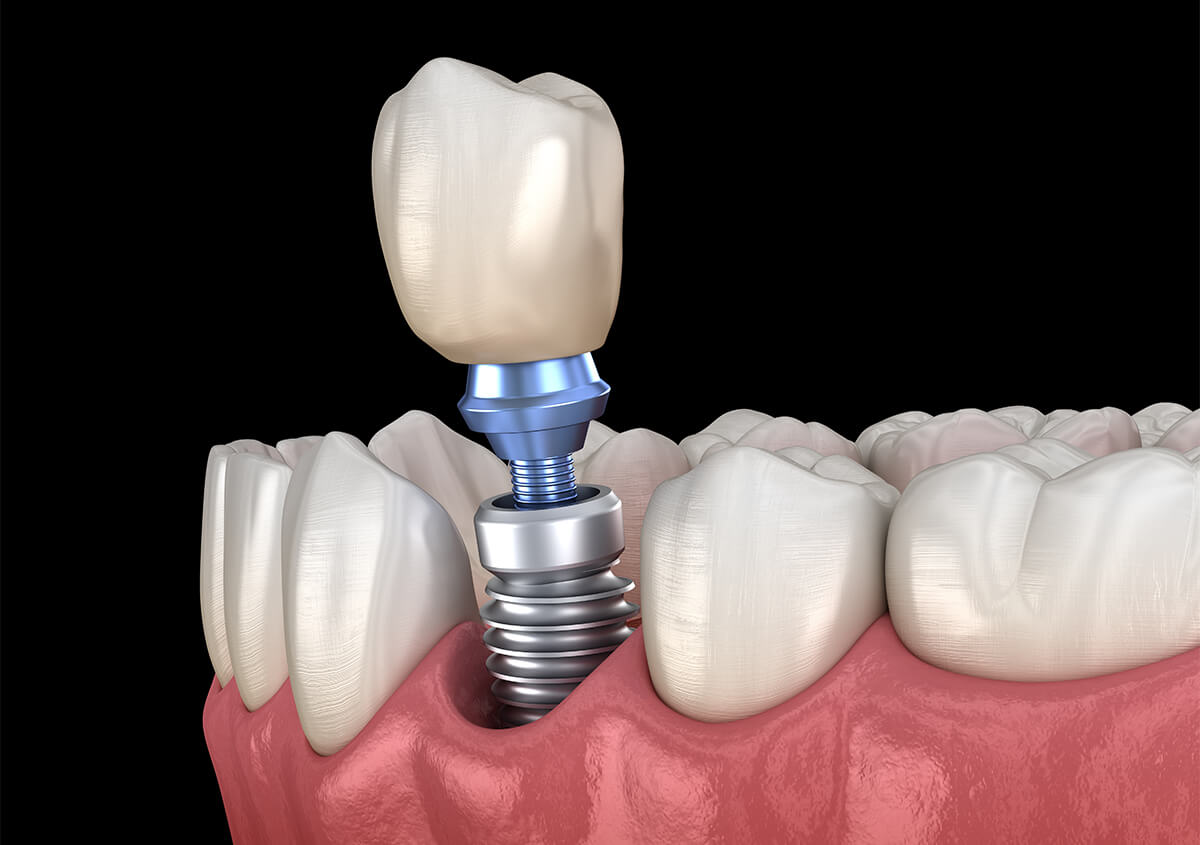One of the best ways to replace missing teeth is placing dental implants. Rather than resting on the gum line like removable dentures, or putting crowns on adjacent teeth and using them as anchors like fixed bridges, dental implants are long-term replacements placed by an oral and maxillofacial surgeon. Therefore, dental implants are an adequate choice for replacing missing teeth.
Years ago, patients would have had no alternative but to employ a fixed bridge or removable denture to restore their ability to eat, speak clearly, and smile. Fixed bridges and removable dentures, however, are not the perfect solution and often bring with them other problems such as recurrent decay, fractures of the bridge structure or supporting tooth. Removable dentures may slip or cause embarrassing clicking sounds while eating or speaking. Fixed bridges often affect adjacent healthy teeth, and removable dentures often leads to bone loss in the area where the tooth or teeth are missing. Recurrent decay, periodontal (gum) disease and other factors often contribute to failure of fixed bridgework to early failure. For these reasons, fixed bridges and removable dentures usually need to be replaced every few years.
Dental implants are another option for patients who are missing permanent teeth. Dental implants are long-term replacements. Composed of titanium metal that “fuses” with the jawbone, this process called osseointegration, means that dental implants can never slip or make embarrassing noises that advertise the fact that you have “false teeth”. Additionally, they never decay the way teeth anchoring fixed bridges do. Because dental implants fuse with the jawbone, bone loss is generally not a problem.
Oral and Maxillofacial Surgeons in the United States have been placing dental implants for approximately 25 years. Clinical data shows that the vast majority of first dental implants placed continue to still function well for patients. More importantly, the recipients of those early dental implants are still satisfied they made the optimal choice. When properly cared for, a dental implant can last a lifetime.
Anatomy of a Dental Implant

A dental implant is composed of three parts: the titanium implant that fuses with the jawbone; the abutment, which fits over the portion of the implant that protrudes from the gum line; and the crown, which is the actual tooth part created by a prosthodontist or restorative dentist and fitted onto the abutment for a natural appearance.
Many people who are missing a single tooth opt for a fixed bridge; but a bridge will require the cutting down of healthy, adjacent teeth that may or may not need to be restored in the future. Then there is the additional cost of possibly having to replace the bridge once, twice or more over the course of time. Also, a removable partial denture may contribute to the loss of adjacent teeth. Studies have shown that within five to seven years there is a failure rate of up to 30% in the teeth located next to a fixed bridge or removable partial denture.
Conventional dentures may lead to the loss of bone in the area where teeth are missing. When a tooth is missing, the bone may erode and weaken until it may be necessary for the oral and maxillofacial surgeon to do bone grafting in that area to strengthen it for placement of a dental implant. Dental implants fuse to the bone (process called osseointegration), and provide stability, just as a natural tooth does. If you are missing several teeth in the same area, you still can enjoy the confidence and benefits that come with dental implants. By placing two or more dental implants, depending on the number of teeth that are missing, the replacement teeth will be attached to the implants which allow excellent function and prevent bone loss. The implants will serve as a stable support that tightly locks into your replacement teeth or dentures to prevent slipping and bone loss.
Dental implants have an overall success rate of about 95% and almost 50 years of clinical research to back them up. Due to this high success rate, dental implants frequently are the best treatment option for replacing missing teeth.
Dental Implants vs. Conventional Dentures
Patients who have selected dental implants are much more comfortable than those with fixed bridges or removable dentures. Dentures often make a person feel and look older than they are, cause embarrassment in social situations when they slip and click, and restrict the everyday pleasure of eating comfortably. When they count the benefits they enjoy as a result of their dental implants, patients say their implants eliminate the day-to-day frustrations and discomfort of ill-fitting dentures. They allow people to enjoy a healthy and varied diet without the restrictions many denture wearers face.
Dental Implants are a Team Effort
A successful implant requires that all parties involved — the patient; the restorative dentist, who makes the crown (tooth) for the implant; and the oral and maxillofacial surgeon, who surgically places the implant.
Is necessary to have an evaluation including comprehensive examination, x-rays and a consultation with the patient and members of the implant team.
Are You a Candidate for Dental Implants?
Any adult in need of replacing one tooth, several teeth, or all of their teeth, could be a candidate for implants.
- Existing Medical Conditions: If you can have routine dental treatment, you generally can have an implant placed.
- Gum Disease: Most implants placed in patients who have lost their teeth due to periodontal (gum) disease or decay, have been successful.
- Currently wearing partials or dentures: Implants can replace removable bridges or dentures, or they can be used to stabilize and secure the denture, making it much more functional and comfortable.
- Smokers: Smoking may lower the success rate of implants, but still doesn’t eliminate the possibility of getting them.
- Children: Tooth replacement with an implant in children is usually deferred until their jaw growth is complete (around 18 years of age). There may be some instances when a dental implant is appropriate, such as when it is part of the child’s orthodontic treatment plan.
Need more information?
Send us a message or call us at (858) 434-7554, we’d be glad to help you and explain anything you want to know more about.

Dental implants are titanium roots, that are replaced with in the jawbone to resemble a tooth or group of teeth. A screw is inserted through the gums and into the jawbone. A porcelain crown is then attached to the screw to become the new tooth or teeth. They can be used to support dental prosthesis including crowns, dentures, and bridges. Today’s treatments are so natural looking, no one will know you had surgery. There’s approximately a 95% success rate for all implants. With modern advances in dentistry, some implants can be restored immediately with life like all porcelain crowns. For more details ask your dentist.


